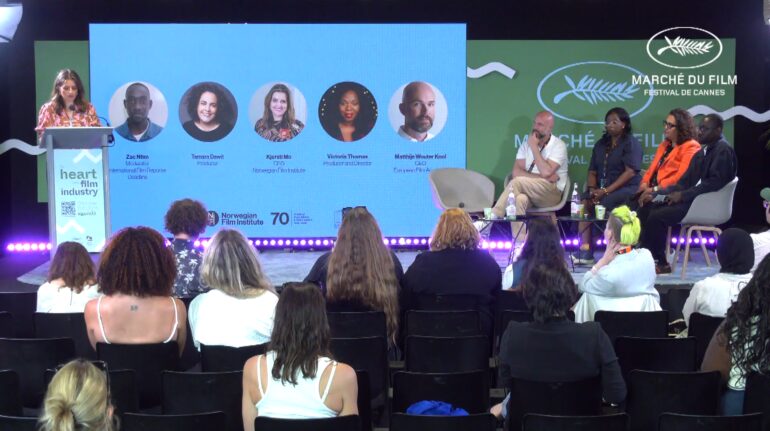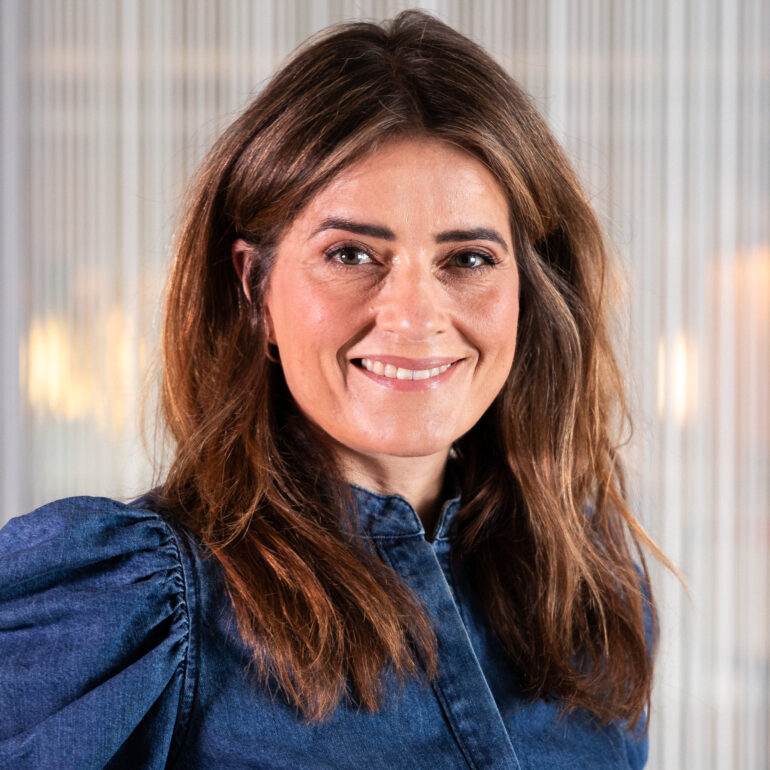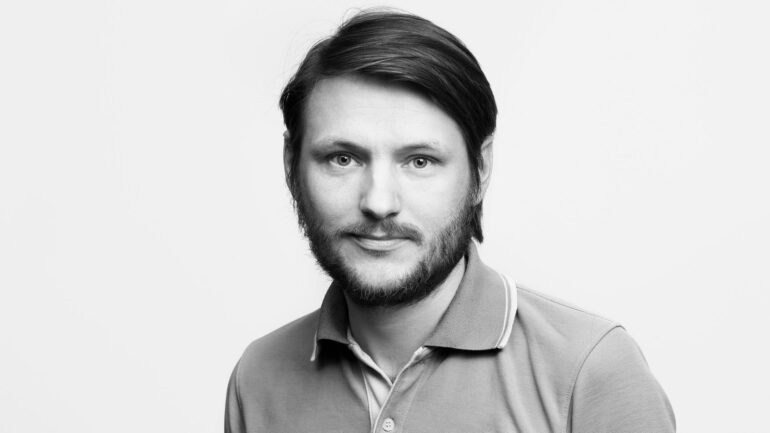WRITTEN BY: Davide Abbatescianni
As Hollywood retreats, Nordic countries push forward, showing how gender parity drives innovation, not just inclusion, in film.
When conversations about gender equality in cinema arise, many eyes turn west to Hollywood. But as the American industry backpedals on diversity and inclusion efforts, the Nordic region is charting a different — and, arguably, more sustainable — path. On May 19, 2025, the Norwegian Film Institute hosted a thought-provoking panel at the Cannes Film Festival titled “The Future is Diverse: Building Sustainable Pathways for Inclusive Cinema”. The discussion, led by Deadline journalist Zac Ntim and featuring producer Tamada Dawit, producer-director Victoria Thomas, European Film Academy CEO Matthijs Wouter Knol, and Norwegian Film Institute CEO Kjersti Mo, made one point resoundingly clear: In the Nordics, equality is not a quota, it’s a creative force.
During the panel, Mo described the present moment as a “pivotal” one. “The future of diversity directly impacts the quality of our storytelling,” she declared. In her view — and those of her Nordic colleagues — public institutions must lead by example. They must act as structural catalysts, not just philosophical supporters. And the results are beginning to show.
Norway: symbolism meets structure
In 2024, for the first time in Norway’s history, female directors received higher average production budgets than their male counterparts. For Mo, this wasn’t a statistical anomaly — it was a sign that “long-term, collective efforts are paying off”. Yet she is quick to underline that gender parity is not an end in itself. “Gender balance remains the goal — not the highest possible percentage of women,” she notes. The wider goal is broader: inclusive cinema in its most pluralistic form, across gender, ethnicity, geography, and background.
To that end, Norway has implemented a suite of programmes — such as UP and NEO — targeting emerging talent and supporting underrepresented creators. Importantly, the NFI collects voluntary diversity data, enabling it to track who’s applying for funding and who’s not. “While we’ve reached parity in outcomes, only 42% of our applicants are women,” Mo says. This reveals a deeper systemic imbalance — one that requires industry-wide action, including from film schools and regional centres.
Norway also employs a principle of “moderate affirmative action”: If two projects are of equal quality, the one with more women in key creative roles gets the edge. Mo is adamant this doesn’t compromise artistic integrity. “There is no contradiction between merit-based assessment and structural correction,” she insists. “Artistic freedom remains fundamental — but it must be accessible to all.”
Perhaps most compelling is the visible change in storytelling. With over 60% of producers in Norway now women, films like Loveable (Elskling) by Lilja Ingolfsdottir — which achieved both international festival success and domestic box office wins — are becoming more common. “It’s a strong, emotionally layered portrait that might not have been made ten years ago,” Mo reflects. The result? A richer, more resonant cinematic landscape.
Finland: from strategy to sustained success
Finland’s journey toward gender equality in film also began with strategic clarity. In 2018, the Finnish Film Foundation launched a dedicated action programme, blending research, transparency, and communication. “We’ve reached a near 50/50 gender balance within our funded projects over several years,” explains Lasse Saarinen, the body’s CEO. While fluctuations still occur — understandable in a small industry — the trajectory is clear.
A key innovation has been the mandatory “Equality Tool” co-developed with Women in Film & Television Finland (WIFT), now required for all production support recipients. The tool encourages filmmakers to incorporate gender equality at the planning stage, not just as an afterthought. According to Saarinen, it has contributed to a significant rise in female applicants — from under 30% to over 40% over the last decade.
Finland’s efforts are backed by data transparency. Detailed gender statistics have been published since 2011 and are actively used to shape future strategies. “It’s also a way to encourage more women to apply,” says Saarinen. “When they see that women’s projects tend to succeed, it builds confidence.”
Sweden: cultural conversation as catalyst
Sweden’s approach has leaned heavily on cultural shifts and public discourse. While Charlotta Denward, Head of Production and Development at the Swedish Film Institute (SFI), offered recent figures and acknowledged the impact of several initiatives aimed at boosting women in leadership positions. “We believe the discussion has opened doors,” she notes.
SFI data from 2020 to 2024 highlights gender disparities in film funding across roles and genres. In general production, women directors stayed around 44–47% until a drop to 39% in 2024. Women screenwriters peaked at 53% in 2021, but declined to 38%, while female producers consistently represented about half, rising to 57% in 2024.
In commissioner-funded feature fiction, women directors declined sharply from 64% in 2020 to 31% in 2024. Screenwriters and producers followed similar downward trends, though producers remained relatively high at 68%. Short fiction also saw falling female representation across roles, with women directors dropping from 54% in 2021 to 37%, and screenwriters from 56% to 31%. Meanwhile, producers fell from 69% to 41%.
Feature documentaries showed gains, with women directors increasing from 35% in 2020 to 50% and producers from 43% to 69%. However, women screenwriters dropped to 33% after a 2021 peak. Short documentaries had the best gender balance in 2024, with 89% women directors and screenwriters, and 72% producers. Additionally, in 2024, up to 11% in some categories identified as a gender other than woman or man.
The SFI collects annual gender data and, like its Nordic counterparts, recognises that attracting more female applicants starts early. “Film schools and other initiatives at earlier levels need to focus on this,” Denward argues, acknowledging that professional-level policy must be complemented by upstream efforts in education and outreach.
Sweden also remains actively engaged in cross-border collaboration, particularly with the other Nordic funds. “This is ongoing,” she says. In a region already known for its cooperative spirit, this sharing of best practices may prove one of the most powerful tools for accelerating change.
Iceland: small nation, big gains
Though smaller in scale, Iceland punches above its weight when it comes to gender equality in film. Between 2020 and 2025, the country saw 10 new female directors debut — a striking figure, considering the total of 14 new directors overall. “Where women apply, they tend to succeed at higher rates than men,” says Davíð Kjartan Gestsson, of the Icelandic Film Centre.
And while female application rates remain a challenge, Iceland leads Europe in several categories. According to the European Audiovisual Observatory, women directed about 37% of Icelandic feature films between 2019 and 2023 — the highest share on the continent. The same upward trend holds for female screenwriters (33%) and producers (38%).
What’s driving these results? A mixture of targeted outreach, robust data tracking, and national commitment. Like its neighbours, Iceland recognises that representation isn’t just a fairness metric — it influences what stories get told, and by whom.
Denmark: promising figures but still more work to be done
Anders Budtz-Jørgensen, of the Danish Film Institute (DFI), highlights the institute’s ongoing commitment to creating a film landscape that truly reflects the population, both in front of and behind the camera. “We work closely with the film industry and other stakeholders to ensure a fair gender balance across all areas of production,” he explains.
Currently, the DFI is restructuring its approach to bring decision-making closer to the CEO and broaden its focus beyond film funding alone, aiming for a more holistic strategy in supporting the industry.
Rather than relying on quotas, the institute focuses on raising awareness around underrepresentation, encouraging producers and filmmakers to make conscious choices. Budtz-Jørgensen elaborates: “We do not work with quotas, because we believe in fostering genuine reflection rather than imposing targets. For instance, when producers receive funding, they are required to complete a form detailing the gender distribution of their production team. This form is designed to encourage awareness and reflection, not to influence funding allocation.”
Despite some encouraging progress, he acknowledges that achieving full gender equality remains a work in progress. “We had promising years in 2020 and 2021, when the gender distribution of directors on feature films was almost equal,” he says. “However, since then, the balance has regressed somewhat, particularly within commercial films.” On a more positive note, Budtz-Jørgensen points out that gender representation on screen is notably more balanced.
Looking at recent data, the Danish Film Institute reports a relatively balanced distribution in funding for fiction feature films over the past two years, including their commissioner scheme, market scheme for commercial films, and the New Danish Screen talent development programme. In 2023, 43% of funded projects were directed by women, a figure that rose to 54% in 2024. “Last year, we funded nine commercial films, with five directed by men and four by women,” Budtz-Jørgensen notes. “These numbers are quite uplifting, and show that progress is being made, although there is still more work to be done.”
The power of Nordic Collaboration
Across Norway, Finland, Sweden, Iceland, and Denmark, a consensus emerges: gender equality in film is not only desirable, it is doable and transformative. “We collaborate very closely within The Five Nordics,” says Saarinen. “Gender equality is no exception.”
Knowledge-sharing, co-productions, joint statistics, and mutual encouragement have made this cluster of countries a quiet powerhouse of progressive cultural policy. And with public funding playing such a central role in these industries, institutions are uniquely placed to embed values of inclusion at structural levels.
Yet these achievements are not without fragility, as the global context is shifting. Political headwinds, budget cuts, and culture wars in larger markets could lead some to question whether the focus on inclusion should persist. For the Nordics, the answer is unequivocal: Yes.
For more information on the pan-Nordic gender balance, check Nordisk Film & TV Fond’s annual reports: CLICK HERE.


